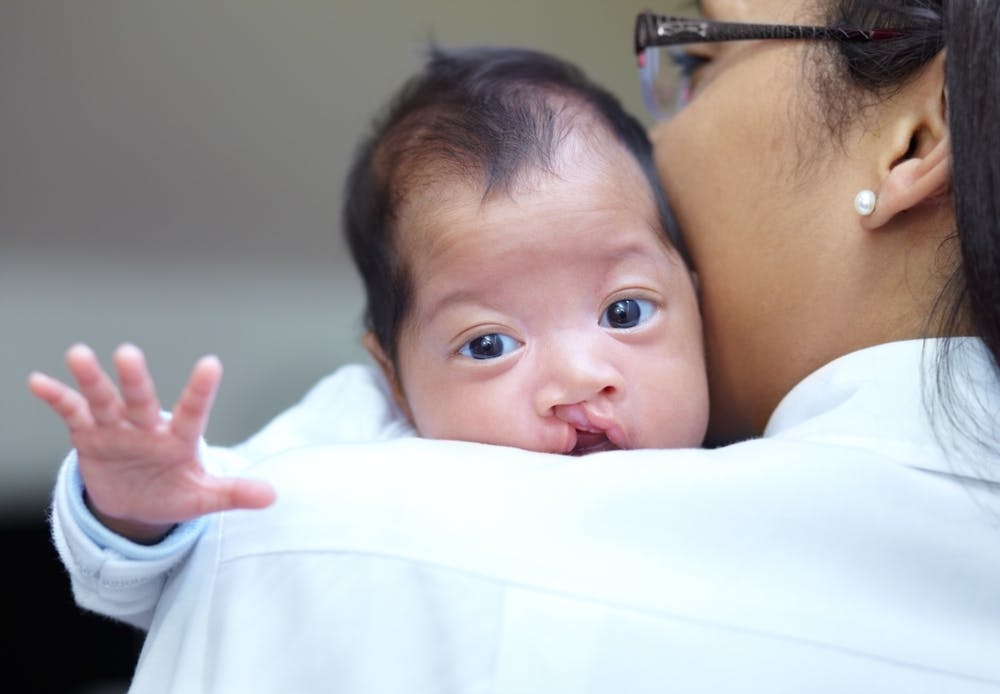Oral clefts, also called orofacial clefts — including both cleft lip and cleft palate — are birth defects where the baby's lip or mouth is malformed during prenatal development. According to the Centers for Disease Control, the incidence in the United States is about 1 in 1,600 for cleft lip and cleft palate; 1 in 2,800 for cleft lip without cleft palate; and 1 in 1,700 for cleft palate alone. Children with a cleft lip or palate often have feeding difficulties, speech problems, and recurrent ear infections. They may also have problems with hearing and dentition.
Prenatal Development and Oral Cleft Birth Defects
The lip forms between the fourth and seventh weeks of pregnancy. As the fetus develops, cells grow toward the center of the face and join there to complete the facial form. If this joining is not complete before birth, an opening in the upper lip results. This opening can vary in size from small to large and can be on one or both sides of the lip or in the middle. Notably, cleft palate can co-occur with cleft lip.
The palate is formed between the sixth and ninth weeks of pregnancy. Again, if this tissue does not completely join in the middle, the palate will be open in either the front, back, or both parts of the palate.
Transabdominal Ultrasound for Prenatal Diagnosis
Fetuses with orofacial clefts are often identified by 2D ultrasound during the second trimester of pregnancy — specifically, during the 20-week routine scan. If that scan is suspicious for a fetal anomaly, the patient is referred to a tertiary care center for more detailed ultrasonography. This screening often includes 3D ultrasound, as well as other diagnostic procedures as indicated, and counseling.
Accurate prenatal diagnosis of the oral cleft birth defect is critical to establish treatment planning, predict prognosis, and counsel parents properly. Studies looking at the accuracy of 2D ultrasonography in low-risk populations show a wide variety of diagnostic accuracy. There is a significant proportion of misdiagnosis.
The Role of 3D Ultrasound
As 3D ultrasound became more widely available, researchers studied whether it could improve the accuracy of oral cleft identification prenatally. A study in Obstetrics & Gynecology showed that axial 3D ultrasound of the fetal palate had high accuracy in identifying cleft palate when cleft lip had been diagnosed with 2D ultrasound screening in the mid-second trimester. The results suggested that axial 3D ultrasound imaging had "good predictive power in terms of sensitivity, specificity, contingency and phi, and there was a strong association between the prenatal diagnoses and postnatal findings," the authors write. Specificity was lower than sensitivity with two cases of overdiagnosis. The axial approach was most effective when the palatine bone was cleft.
A case report published in Maxillofacial Plastic and Reconstructive Surgery discusses the pitfalls and considerations of prenatal ultrasonographic diagnosis of cleft lip with or without cleft palate. The authors discuss the use of 3D ultrasonography to provide more precise images of the condition and to enhance 2D examination. 3D ultrasound can achieve a reliable diagnosis of fetal cleft lip plus cleft palate. Although, for cleft palate alone, magnetic resonance imaging may also be necessary.
Counseling Parents
When expectant parents learn that their baby has a birth defect, they may experience a variety of emotions, including anger, fear, sadness and guilt. Prenatal diagnosis poses challenges for healthcare professionals supporting the parents. However, diagnosis during pregnancy gives the parents time to adjust to the new information and the prognosis for their baby.
3D ultrasound can help provide the information that helps parents prepare themselves both emotionally and practically for their baby's arrival and care. Knowing the diagnosis before delivery allows the care team to make plans for feeding issues and any other considerations for the period immediately after birth. This makes the entire experience go more smoothly for the family.
OB/GYNs should be prepared to support and counsel pregnant women and their partners when a cleft lip or palate diagnosis occurs. 3D ultrasonography can play an important role by providing an accurate diagnosis and detailed information about the nature of the oral clefts so that counselling and preparation for the family can occur.




